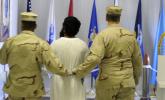 |
 |
Releasing Taliban Detainee From Guantanamo Not Worth The Risk

On Tuesday Reuters reported that the Obama administration is considering the release of Mullah Khairullah Khairkhwa from detention at Guantanamo Bay, where he has been held since 2002. U.S. military assessments characterize Khairkhwa as a “high-risk” detainee and a ”direct” associate of the late al-Qaeda leader Osama bin Laden and Taliban leader Mullah Omar, even though he was more of an administrator rather than a military leader under the Taliban’s ruling body. The administration has argued that his release is a good-faith gesture that will build trust between the Taliban and the U.S., ideally leading to a political settlement to end the war.
In March the Obama Administration’s plan to jump-start peace talks with the Taliban involved the proposed transfer of five Taliban detainees to Qatar where they would be held by the Qatari authorities. U.S. efforts to broker the talks were dealt a blow last month when the Taliban suspended its participation and appeared to reject even minimal restrictions for prisoners transferred to Qatar. Now, according to Reuters, the administration is considering sending Khairkhwa directly to Afghanistan. Although this will surely please the Taliban, it is unlikely to kick off peace talks. There is still a considerable gap between the U.S. and the Taliban on the issues of breaking with al-Qaeda, accepting the Afghan constitution and laying down their arms. The release of Khairkhwa will do nothing to narrow this gap.
Who is Mullah Khairkhwa?
Under the Taliban, Khairkhwa served as an official in a variety of capacities, including the regime’s chief spokesman and minister of Interior. Khairkhwa commanded Taliban forces during the capture of the northern city of Mazar-e Sharif from the Northern Alliance in 1997. After the city successfully rebelled, he led the retreat of the disorganized Taliban forces, which used “scorched earth” tactics and conducted ethnic massacres as they pulled back. Khairkhwa was appointed governor of Herat in 1999, and under his control the anti-Taliban Shi’a-majority province became an important source of taxes for the Taliban regime. He also established himself as the leading narcotics trafficker in the region. Khairkhwa had close personal ties to Osama bin Laden, al-Qaeda in Iraq leader Abu Musab al-Zarqawi, and other al-Qaeda figures, and he oversaw al-Qaeda training camps in heart, according to declassified documents.
Consequences of Release
If Khairkhwa is transferred to Afghanistan, the U.S. will have a more difficult time monitoring his activities and will be unable to restrict his movements, despite the impressive capabilities of U.S. and Afghan intelligence services. Khairkhwa is likely to reconnect with the Taliban’s senior leadership and will surely serve as galvanizing force for the rank-and-file fighters who seldom see or hear from senior leaders. The last senior Taliban detainee who was released from Guantanamo was Mullah Zakir. Today Zakir is the leader of the Taliban’s fighting force and second-in-command to Mullah Omar. After years of hard combat in the south and east, U.S., coalition, and Afghan forces have captured or killed many of the movement’s more respected and talented commanders. Releasing one of the few individuals who could reinvigorate the faltering movement will do more harm than good.